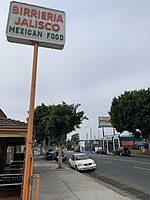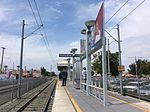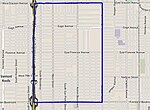Firestone station
1990 establishments in CaliforniaA Line (Los Angeles Metro) stationsCalifornia railway station stubsLos Angeles County, California geography stubsLos Angeles Metro stubs ... and 4 more
Pacific Electric stationsRailway stations in the United States opened in 1990Use mdy dates from December 2019Wikipedia page with obscure subdivision

Firestone station is an elevated light rail station on the A Line of the Los Angeles Metro Rail system. The station is located between Graham Avenue and the Union Pacific freight railroad's Wilmington Subdivision (the historic route of the Pacific Electric Railway), and elevated over the intersection of Firestone Boulevard, after which the station is named, in the unincorporated Los Angeles County community of Firestone Park.
Excerpt from the Wikipedia article Firestone station (License: CC BY-SA 3.0, Authors, Images).Firestone station
Graham Avenue, Los Angeles Watts
Geographical coordinates (GPS) Address External links Nearby Places Show on map
Geographical coordinates (GPS)
| Latitude | Longitude |
|---|---|
| N 33.9599 ° | E -118.2432 ° |
Address
Firestone
Graham Avenue
90002 Los Angeles, Watts
California, United States
Open on Google Maps







